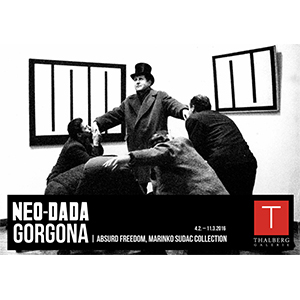February 4 to March 11, 2016
The “Thalberg” Gallery, in cooperation with the “Marinko Sudac” Collection and the Institute for the Research of the Avant-Garde, is delighted to present the exhibition “NEO DADA – GORGONA | Absurd Freedom, Marinko Sudac Collection”. The project is organized in conjunction with the Consulate General of the Republic of Croatia in Zürich, Switzerland.
The activities of “Gorgona”, a notable Neo-Avant-Garde group in Eastern Europe after the Second World War, were inspired by Dadaism. The works by its members are considered to be the preeminent artistic legacy of this movement, and will be on display at “Thalberg” Gallery in a retrospective overview of “Gorgona”’s art practice. “Gorgona” formed as an art group in Zagreb, Croatia, in 1959 and existed until 1966. Its members were the painters Josip Vanista (1924), Julije Knifer (1924 – 2000), Marijan Jevsovar (1922 – 1998) and Djuro Seder (1927) as well as the sculptor Ivan Kozaric (1921) and Miljenko Horvat (1935 – 2012), an architect who also painted and did photographed, along with art critics and art historians Radoslav Putar (1929 – 1994), Matko Mestrovic (1933) and Dimitrije Basicevic Mangelos (1921 – 1987), plus a number of connected informal members and friends of the group.
“Gorgona”’s activities encompass collaborative works, Gorgonic Demeanour-actions, meetings and excursions, written surveys and correspondences (“Thoughts for Months”). They also published 11 issues of the “Gorgona” Anti-Magazine, including a few unpublished drafts. Between 1961 and 1963, they rented the exhibition space “Salon Sira”, which they re-named “Studio G”, and organized a series of group and solo exhibitions of “Gorgona” members and invited guests, such as the artists François Morellet and Piero Dorazio.
Various exhibited works, archival photographs, documentation and correspondence by “Gorgona” members as well as those by prominent figures in the contemporary art scene of the time show that “Gorgona” was not an isolated phenomena rather than part of a wider and simultaneous development of important movements. It also indicates that “Gorgona” was an active participant in the European art scene during the post-war period, which had been built on the rich legacy of the first Avant-Garde and movements such as Dada.
The exhibition has been conceived and curated by the distinguished art historian Jesa Denegri.
Concurrent with the exhibition “Dadaglobe” at the “Kunsthalle”, Zürich, “Thalberg” Gallery joins the elaborate program of events commemorating the centennial anniversary of Dada.
The “Marinko Sudac” Collection is the most significant collection of Avant-Garde art and connected art practices from Eastern European. The collection spans the years from 1922 until the fall of the Berlin Wall in 1989.
The Institute for the Research of the Avant-Garde was established in 2010 as part of a project with the objectives to research, preserve, present and popularize regional historical Avant-Gardes. The Institute brings together the work of the “Virtual Museum of Avant-Garde” and the “Marinko Sudac” Collection.

